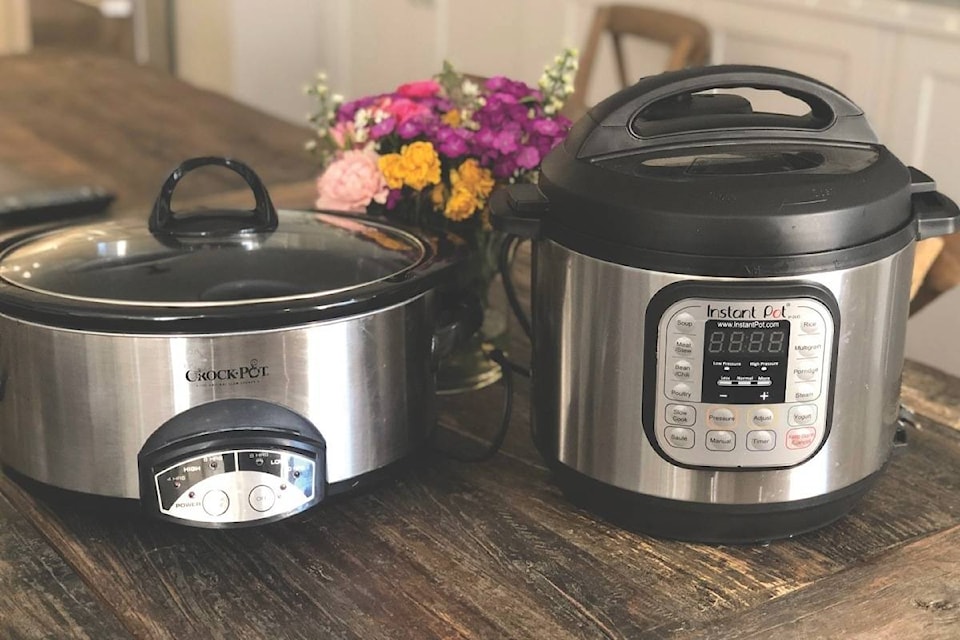Now that the viral craze surrounding the Instant Pot has quieted down a bit, let’s look at whether it really is an appliance you should add to your kitchen, or whether the classic slow cooker will do just fine.
INSTANT POTS
Instant Pot is the most popular brand name for a fairly new breed of programmable, electric, multi-function cookers. There are a number made by other manufacturers too. Instant Pots (we’ll use the popular moniker) are pressure cookers, slow cookers, rice cookers, yogurt makers, steamers and warmers, all in one. They also can brown foods, so you can sear or saute in them.
This last feature is one of the reasons I like mine so much. When making something like pulled pork or braised chicken, I prefer to sear the meat first, before cooking it. This gives the final product more texture, with a nicely caramelized outside and a super-tender interior. With a regular slow cooker, you must do this step in a pan on the stove before transferring it to the slow cooker, which is an extra step and an extra thing to wash.
The main draw of the Instant Pot is the pressure-cooking function. The cooking temperature of an Instant Pot in the “instant,” or pressure-cooker, setting ranges between 239 degrees F and 244 degrees F. Many meals can be cooked in less than 60 minutes, including things that might surprise you if you’ve never had a pressure cooker. Pot roast in an hour? Yup.
The Instant Pot has insulated housing, which makes it energy efficient. You have to seal the pressure valve, and then it locks itself during the pressure-cooking process, which results in no cooking smells. You might think that a pro or a con (I’m a fan of cooking smells myself). The pot raises, monitors and adjusts the pressure automatically, and when the cooking time is finished the valve is released to bring the pressure back down (some recipes say you should release the pressure valve manually, while others allow for the Instant Pot to do this automatically and slowly). The food should be allowed to sit in the Instant Pot until the release time is over — most recipes will be clear on that, and the pot itself unlocks when it’s time to remove the food.
You can certainly use the slow-cooker function on an Instant Pot, but many slow-cooker fans don’t think it’s as good as a designated slow cooker. Because the Instant Pot seals itself so well, even when it’s not on the pressure-cook mode there is less liquid able to evaporate than with a traditional slow cooker. This may result in some liquid left at the end, and less reduction and thickening of sauce as the food cooks.
Most Instant Pots have smart, built-in programs like “rice” or “bean/chili” so you can make certain foods with the press of a button. But overall, it’s less intuitive than a slow cooker, so you should find recipes with explicit Instant Pot instructions. Once you get the hang of it, then you can experiment more.
For steaming, or for other recipes where you don’t want the food submerged in liquid, there is a rack insert to keep the food suspended above a small amount of water or other liquid. This means you can make foods in your Instant Pot that you would not usually make in a slow cooker, such as a lasagna in a pan. There are pans designed just for the slow cookers on the market, and also some silicone slings and other inserts designed for cooking specific foods, such as eggs, and lifting foods from the machine.
THE SLOW COOKER
As the name suggests, the slow cooker cooks foods low and slow, with a temperature range of about 175 degrees F to 200 degrees F. There are usually only two settings, low and high the high setting usually has a minimum cooking time of four hours and a maximum of six, with the low offering a choice between eight and 10 hours.
Most recipes specify which setting and amount of time to use, but I’ve found that some recipes, like a roast or pork shoulder, can be flexible, so you may choose a setting and time based on how much time you have (for example, if you are cooking something in the afternoon for dinner, or overnight while you sleep).
The slow cooker is more intuitive for most cooks than the Instant Pot. Fewer functions (one) mean fewer buttons, and it’s harder to mess anything up.
Slow cookers are available in sizes up to 10 quarts, while Instant Pots top out at 8 quarts, so if big-batch cooking is your thing, that’s a consideration.
WHAT THEY BOTH DO
Both machines are good for foods with lots of moisture and long cooking times, such as soups, chilies, stews and braises. With both, the cooking time can usually be preset, and foods can be kept warm after cooking is finished.
WHICH IS RIGHT FOR YOU?
If you are a person with lots of the appliances that an Instant Pot can replicate, such as a yogurt maker, a slow cooker, a pressure cooker and a rice maker, then boy, will you save a lot of storage space with this one device. And if you are a last-minute dinner maker, then the Instant Pot might become an invaluable tool. But if you are someone who plans ahead, loves slow-cooked foods, and wants to walk in the door to a house filled with the scent of dinner waiting to be served up, then stick with the slow cooker.
Me? I have both. And I use both. I use my big slow cooker for slow cooking, and I use my Instant Pot mostly for searing and pressure cooking. At some point, I might pick a lane and stick to it, but for now, I’m making room for both of them.
Katie Workman
THE ASSOCIATED PRESS
